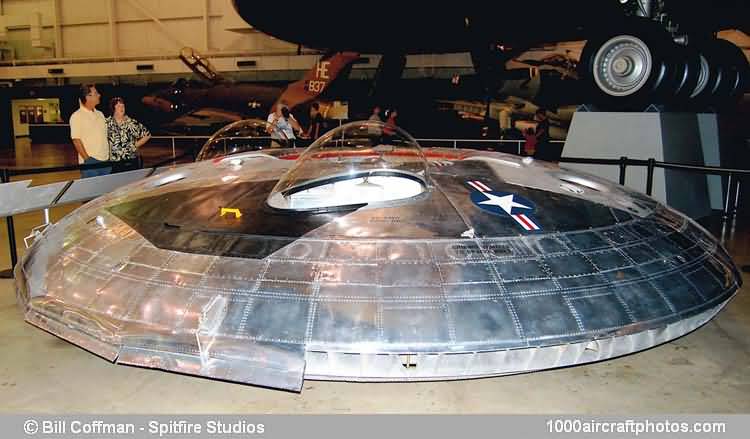03/31/2009. Remarks by Johan Visschedijk: "Avro Canada's Chief Designer John Frost investigated the 'Coanda-effect' ground cushion effect provided by a disk-shaped vehicle, that would have the potential capability of VTOL and could still operate as a high-performance aircraft.
Started in 1951 as a fighter-bomber concept, it was initially funded by the Canadian government, after government funding was dropped, the project was offered to the US Department of Defense in 1955. In 1958 the project was transferred to the USAF and US Army, the services goals were respectively a supersonic VTOL combat aircraft and a subsonic, all-terrain troop transport. Subsequently two research aircraft were built at Toronto, Canada, designated VZ-9AV Avrocar.
The two-seat Aviocar was powered by three 1,025 lb Continental J-69 (license-built Turboméca Marboré II) turbojets, their exhaust gasses drove a central impeller ("turbo-rotor") producing downward thrust to hover, while a vane/shutter system provided directional control, when directed rearwards the aircraft would accelerate and by the lifting shape of the fuselage it would gain altitude.
The first Avrocar, s/n 58-7055 and coded "AV-7055", never left the ground on its own power, it was used for initial wind tunnel tests at NASA Ames in California, USA, returned to Avro Canada at Malton, Ontario, Canada in 1959 for static rig tests, while it was shipped to NASA Ames again for two series of full-scale wind tunnel tests, commencing in April 1960 and in April 1961.
The second Avrocar, s/n 59-4975, commenced tethered flight testing at Malton in 1959, and on November 12, company test pilot "Spud" Potocki made the first free-flight test. The aircraft displayed uncontrollable pitch and roll motions, known as "hub-capping", and it could only reach a maximum speed of 35 mph (56 kmh). By the summer of 1961 the Aviocar had also been flown by Avro test pilot Peter Cope, USAF project pilot Major Walter J. Hodgson and by NASA Ames Chief Test Pilot Fred J. Drinkwater.
A total of ca. 75 flight hours were recorded, however, after all attempts to end the "hub-capping" failed, the program was cancelled in December 1961. The first Aviocar was subsequently stored and donated to the NASM in 1966, it was transferred to the National Museum of the USAF in 2007. The second Avrocar was kept at the US Army Aviation Materials Laboratories at Fort Eustis, Virginia, it was transferred to the US Army Transportation Museum at Fort Eustis in 1979."
